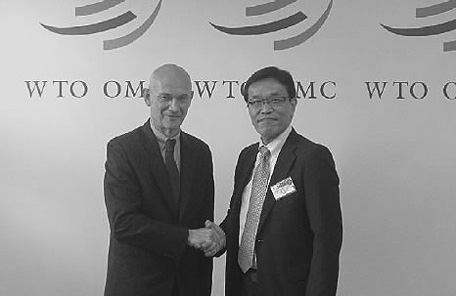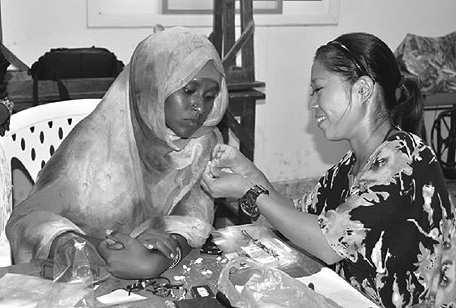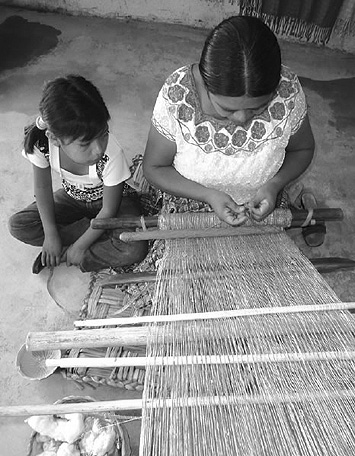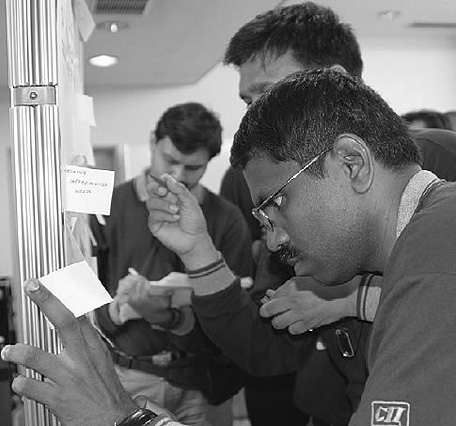Japan's Official Development Assistance White Paper 2011
(3) Cooperation between Trade, Investment, and Other Official Flows (OOF)
It is a key that the private sector plays a leading role for sustainable growth in developing countries. Also it is important to revitalize private-sector activities such as the development of industry and the expansion of trade and investment. However, in developing countries beset by a variety of challenges it can sometimes be difficult to set in place an environment that attracts private investment. Therefore supports from the international community are required.
<Japan's Efforts>
Japan utilizes ODA and Other Official Flows (OOF*) to support the advancement of small and medium-sized companies in developing countries, the transfer of Japan's industrial technology, and the formulation of economic policies. In addition, Japan supports the environment of the trade and investment and development of the economic infrastructure in order to improve the export capabilities and competitiveness of developing countries.

Parliamentary Senior Vice-Minister for Foreign Affairs Chiaki Takahashi meets with WTO Director-General Pascal Lamy at the WTO Third Global Review of Aid for Trade (AfT) Ministerial Level Meeting in Switzerland
The World Trade Organization (WTO) Doha Round Negotiations (the Doha Development Agenda)* which started in 2001 also emphasizes the promotion of development through participation in the multilateral free trading system by developing countries. Japan has contributed to the trust fund set up within the WTO in an aim to improve the capacity of developing countries to engage in trade negotiations and participate in the global market, thereby gaining the ability to carry out the WTO agreements.
Regarding access to Japanese markets, Japan has implemented the Generalized System of Preferences (GSP), which adopts lower tariff rates than general rates for exports of products from developing countries. In particular, Japan provides duty-free quota-free access* for Least Developed Countries (LDCs*). In addition, Japan also actively promotes Economic Partnership Agreements (EPAs*), and supports economic growth in developing countries through the liberalization of trade and investment.

A Japan Overseas Cooperation Volunteer teaches graduates of a school of home economics in Djibouti. Their products are sold to members of the Japan Self-Defense Forces and others as souvenirs. (Photo: Seico Tamai)
In recent years, discussions have intensified over Aid for Trade (AfT*) at various international forums, including the WTO and Organization for Economic Co-operation and Development (OECD), as a means of further promoting support by developed countries, including Japan. At the Second Trade Global Review Meeting on Aid for Trade held in July 2009, Japan announced its own new strategy for Aid for Trade called "Development Initiative for Trade 2009,"* with approximately $12 billion in total support for trade-related projects in three years from 2009 to 2011. This includes technical cooperation such as the dispatch of 40,000 experts and acceptance of trainees over the same period. The Initiative has garnered high praise from numerous countries. The project is currently making steady progress. In terms of specific initiatives, Japan provides funds for the development of transportation networks vital to trade, including ports, roads, and bridges, as well as for projects to construct power plants and power grids, etc. It also provides technical cooperation in trade-related areas, including the education of customs officials. Japan also provides assistance to small-scale production groups and small companies in developing companies for the One Village, One Product Campaign*. In addition, Japan aids developing countries in attracting private sector investment by finding challenges unique to developing countries, recommends measures to promote investment, and otherwise encourages private investment.
Further, Japan is proactively engaged with Regional Technical Group on Aid for Trade for Asia and the Pacific which researches successful examples of development assistance that has contributed to economic growth through exports in the Asia region. At the Third Aid for Trade Global Review Meeting held in July 2011, examples of Japan's success in development assistance and other results from meetings of the Technical Group were introduced to representatives of other regions, and garnered high praise from participating countries.

A Mayan resident weaves traditional textiles under the direction of a Senior Volunteer in Guatemala (Photo: Sadao Muraoka)
Terminology
*Other Official Flows (OOF)
Flows of funds to developing countries from the public sector which are not considered to be ODA because the main purpose is not development. Examples include export credit, direct investment, financing of international organizations, etc.
*Least Developed Countries (LDCs)
Countries deemed by the United Nations to be particularly lagging in development even compared to other developing countries, based on the income classifications of developing countries. Countries that meet certain criteria, including a per capita gross national income (GNI) of $905 or less. Currently, there are 48 countries that have been so designated: 33 in Africa, 9 in Asia, 5 in Oceania, and 1 in Latin America.
*Economic Partnership Agreement (EPA)
A broad economic agreement between specific countries (or regions) that, in addition to free-trade agreements (FTA) that stipulate the elimination of customs duties and the liberalization of trade in services and goods, addresses non-trade issues, such as the movement of natural paerons, investment, government procurement, and bilateral cooperation, etc.
*One Village, One Product Campaign
Overseas utilization of an approach that began in Oita Prefecture in 1979. The aim is to create jobs and revitalize the community by developing unique local products through the utilization of local resources and traditional technology. Efforts are made to discover handicrafts, textiles, toys, and other attractive products that emanate the unique ethnic characteristics of developing countries in Asia and Africa, etc., and spread them out to a wider range of people, thereby aiding in the improvement of exports of products from developing countries.
*Doha Round Negotiations (the Doha Development Agenda)
Negotiations between multiple WTO member countries aimed at liberalizing trade in a wide range of fields, including reduction/elimination of customs duties on industrial products and agriculture, forestry and fisheries industry products, and loosening regulations in the service sector. One of their challenges is the development of developing countries through trade.
*Duty-free quota-free access
Measures implemented by the developed world to eliminate customs duties, quotas, and other obstacles to exports from least developed countries (LDCs) to the developed world. The number of target products has been expanding, and approximately 98% of products exported by LDCs to the developed world can be imported without payment of duties and without quotas. (As of November 2011)
*Aid for Trade (AFT)
Assistance is provided to development countries to support efforts to improve trade-related capabilities and to prepare and maintain the infrastructure, for the purpose of aiding developing countries in achieving economic growth under the WTO’s multilateral trade structure.
*Development Initiative for Trade 2009
Comprehensive measures to support the sustainable development of developing countries through trade. For developing countries to enjoy the benefits of a free trade system, not only must trade be liberalized, but it must be built on the three pillars of (i) production (improvement of the ability to produce competitive products), (ii) distribution and marketing (preparation and maintenance of a domestic and overseas logistics system including the distribution infrastructure), and (iii) purchasing (pioneering of markets). The aim is to combine means of assistance such as "knowledge and technology," "funds," "people," and "systems" with these three aspects, and provide comprehensive support that connects producers and laborers in developing countries to consumers in the developed world and developing countries.
[Ukraine]
"Ukraine-Japan Center"
Technical Cooperation Project (May 2006 - May 2011)
Ukraine became independent from the Soviet Union in 1991, and the transition to a market economy did not go smoothly due to lack of human resources to introduce such new ways of thinking, entrench new ideas in society, and develop the ideas further for the benefit of the society. Thus, the development of such human resources has been an issue. To address this issue, Japan established the "Ukraine-Japan Center" as a site to foster human resources capable of making contribution to Ukraine's economic development and promoting cooperation between the two countries in various fields. The activities of the Center are diverse, and revolve around (i) the development of business people (business administration courses, trade investment seminars, collaboration among government, industry, and academia, etc.), (ii) Japanese language education, and (iii) promotion of mutual understanding (introducing Japanese culture, etc.). These efforts yielded many outcomes, for example; Japanese management techniques were adopted by the government and businesses, and the Hiroshima-Nagasaki Peace Study Course was added to universities' curriculum. In addition, networks have been established among business, government, and the general public of Ukraine and Japan; as a result, mutual understanding between the people of both countries has deepened. The Center has become widely popular with the people of Ukraine as a good example of "Visibility of Japanese Aid," and has served as a hub for exchange with Japan.

A business seminar conducted by Japanese experts (Photo: Ukraine-Japan Center)
[India]
"Project for Visionary Leaders for Manufacturing Program (VLFM)"
Technical Cooperation Project (August 2007 - Current)
In August 2007, when India's manufacturing industry was seeking change, the "Project for Visionary Leaders for Manufacturing Program" was launched to let India know Japan's style of production, then develop India's own style of manufacturing techniques to strengthen India's manufacturing industry. Under the India's first system of collaboration among government, industry, and academia, four courses were offered for employees categorized by job title in the participating company. Over 400 individuals have completed the required courses, and are now active in India's manufacturing industry. Through the dedicated guidance of chief advisors and specialists dispatched from Japan, participants have learned not only manufacturing techniques, but also Japan's style of work discipline, and became leaders in the manufacturing industry. In addition, the individuals who completed the project's courses have created products that have had an impact on the manufacturing industry, including the development of "ChotuKool," a scaled-down refrigerator, and creating a submersible pump in collaboration with farmers, who are also their customers. The project was originally scheduled to end in August 2010, but Japan and India agreed to continue it until March 2013, to enable India to carry it autonomously in a sustainable manner.

Senior management course training in Japan (Photo: JICA)
